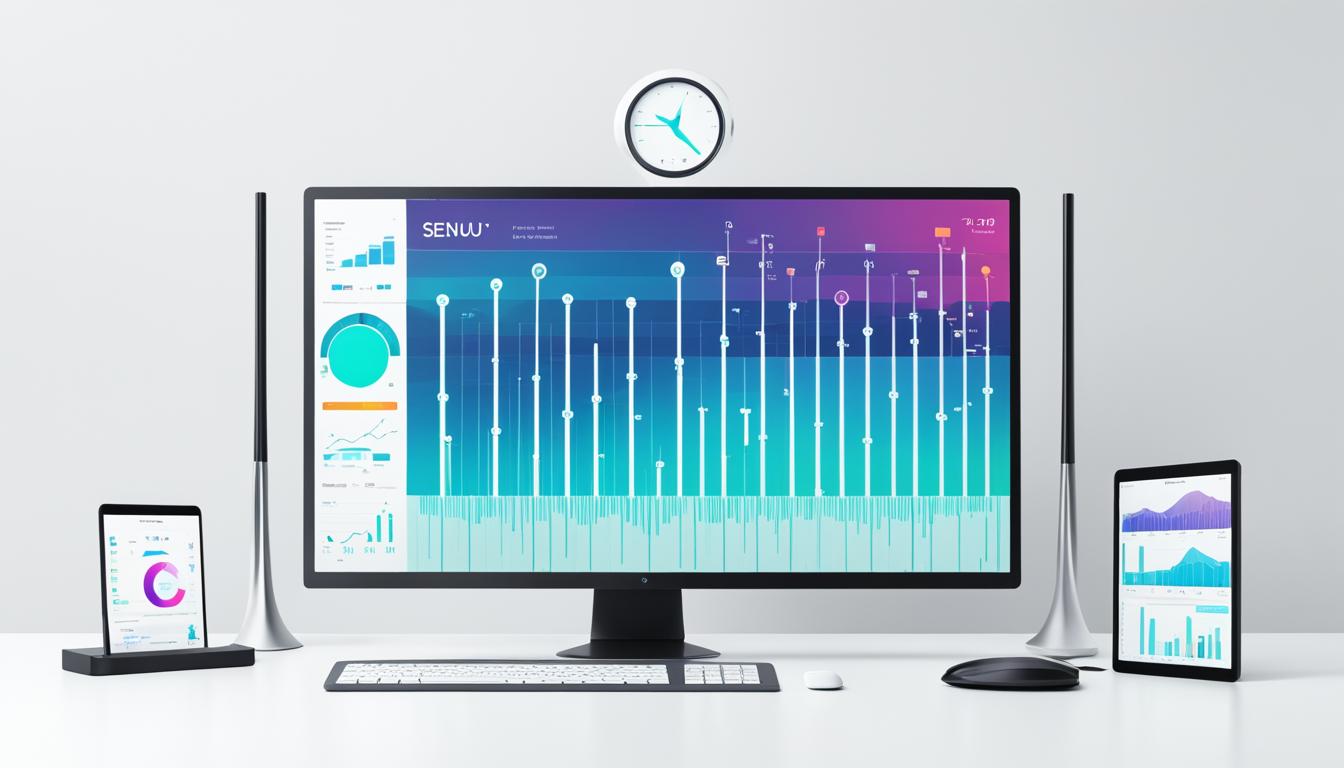What is Sensu: Your Guide to Modern Monitoring
Are you struggling to monitor your cloud-native infrastructure efficiently? Want to automate your monitoring workflows and achieve instant visibility into your dynamic cloud environment? Look no further, because Sensu has got you covered!
Sensu is an observability platform that delivers monitoring-as-code for any cloud environment. Designed specifically for enterprises transitioning from legacy IT infrastructure to ephemeral cloud and container-based environments, Sensu empowers DevOps and SRE teams to automate monitoring configurations and treat monitoring as code.
But what exactly is Sensu, and how can it benefit your business? Let’s dive in and explore the definition, features, and architecture of Sensu, as well as its advantages in achieving business continuity, supporting container adoption, enabling monitoring-as-code, integrating with best-of-breed products, and enhancing enterprise security.
Key Takeaways:
- Sensu is an observability platform that provides monitoring-as-code for any cloud environment.
- It enables DevOps and SRE teams to automate monitoring workflows and achieve instant visibility into cloud-native infrastructure.
- Sensu supports business continuity during cloud adoption and digital transformation initiatives.
- It offers advantages for container adoption, monitoring-as-code practices, integration with best-of-breed products, and enterprise security.
- With Sensu, you can monitor your dynamic infrastructure efficiently and treat monitoring as code.
Sensu Advantages
Sensu is a powerful Monitoring-as-Code platform designed specifically for the Cloud, offering a range of advantages that address the unique challenges associated with the elastic nature of cloud computing. Let’s explore some of the key benefits:
Automated Registration and Deregistration
Sensu simplifies the monitoring process by automating the registration and deregistration of new endpoints, including compute instances and containers. This automation ensures that monitoring remains seamless and efficient, even in highly dynamic environments.
Dynamic Infrastructure Monitoring
Monitoring dynamic infrastructure can be a complex task, but Sensu excels in this area. By eliminating the need to manage host and hostgroup configuration objects found in traditional monitoring tools, Sensu streamlines the monitoring process and reduces the associated challenges. This means that DevOps and SRE teams can focus on automation and configuration changes, treating monitoring as code.
OpEx Reduction
False positive alerts triggered by decommissioned workloads can result in unnecessary operational expenses (OpEx). Sensu’s intelligent monitoring capabilities minimize false positives, enabling organizations to reduce costs and allocate their resources more effectively.
Seamless Migration and Integration
Sensu supports the migration of existing service checks from well-known monitoring tools like Nagios, Zabbix, OpsView, and Icinga. This seamless migration process ensures that organizations can leverage their existing monitoring investments while benefitting from Sensu’s advanced monitoring capabilities. Additionally, Sensu offers support for both battle-tested data sources and plugins, as well as newer data sources like Prometheus, all in a unified platform.
“Sensu’s automation capabilities help DevOps and SRE teams streamline monitoring configuration changes and treat monitoring as code.”
With Sensu, monitoring becomes a seamless part of your cloud environment. Sensu integrates effortlessly with a wide range of best-of-breed observability solutions, including Elastic, Splunk, Influx, Wavefront, Prometheus, Grafana, and operational tools like PagerDuty, ServiceNow, Rundeck, and Moogsoft. This integrability ensures that organizations can create a comprehensive and unified monitoring ecosystem.
As an added advantage, Sensu is designed to meet the needs of modern IT practices such as DevOps and Site Reliability Engineering (SRE). With its Monitoring-as-Code approach and service-based declarative configuration model, Sensu empowers teams to automate monitoring configuration changes and efficiently manage monitoring at scale.
Sensu is armed with advanced features that cater to the ever-evolving IT landscape, providing organizations with the tools they need to embrace the Cloud, containerization, IoT, and more. Its enterprise-level security features, including monitoring agent and publish/subscribe architecture, ensure that your monitoring infrastructure remains robust and secure. Sensu’s integration with HashiCorp Vault for secrets management and support for access management with Single Sign-On (SSO) providers and role-based access controls further enhance its security capabilities.
With Sensu, organizations can adopt a proactive monitoring approach, enabling them to resolve issues faster and ensure optimal performance. Whether your focus is on business continuity, container adoption, monitoring-as-code, or embracing the IoT, Sensu provides an all-encompassing solution that can meet your monitoring needs.
Next, let’s dive into the benefits of using Sensu for business continuity in section 3.
Business Continuity with Sensu
Large F-500 enterprises widely rely on Sensu for monitoring both legacy infrastructure and multi-cloud environments. With Sensu, these organizations can ensure business continuity while transitioning to the cloud and implementing digital transformation initiatives.
Sensu enables enterprises to reuse existing data sources and plugins, allowing for a seamless integration of legacy monitoring systems with the newer and more advanced Sensu platform. This interoperability ensures that organizations can maintain continuity in their monitoring processes, leveraging familiar tools while embracing the scalability and flexibility provided by Sensu.
By providing a unified platform for monitoring across different contexts, Sensu allows for consistent monitoring practices throughout various environments. This not only simplifies the monitoring workflow but also ensures that critical business functions remain monitored, regardless of the infrastructure they reside on. Whether an organization operates on legacy infrastructure or adopts a multi-cloud strategy, Sensu delivers the necessary monitoring capabilities to sustain business continuity.
Overall, Sensu empowers large enterprises to navigate the complex landscape of cloud adoption and digital transformation while maintaining uninterrupted business operations. Its ability to monitor legacy infrastructure alongside dynamic multi-cloud environments ensures that organizations can rely on Sensu to preserve business continuity throughout their transformation journey.
Sensu and Container Adoption
As enterprises increasingly embrace cloud technologies and migrate their infrastructure to the cloud, the adoption of containers and container orchestration platforms like Kubernetes has become crucial. Sensu, with its powerful observability platform, plays a vital role in facilitating smooth container adoption and ensuring seamless integration with Kubernetes environments.
Sensu offers comprehensive support for containers, allowing organizations to monitor their containerized applications and services effectively. With Sensu, enterprises can avoid delays in cloud migrations and digital transformation initiatives by leveraging a monitoring solution that is natively designed for modern cloud-native environments.
One of the key advantages of Sensu in container adoption is its ability to provide on-demand distribution of traditional monitoring plugins in cloud-native environments. This innovative approach enables organizations to seamlessly incorporate their existing monitoring tools and practices into containerized environments without significant rework.
“Sensu’s on-demand distribution of traditional monitoring plugins in cloud-native environments eliminates the need for organizations to rebuild their monitoring infrastructure from scratch when transitioning to containers.”
By leveraging Sensu’s flexible architecture, organizations can effectively monitor their containerized applications, manage the dynamic nature of container environments, and scale their monitoring capabilities as their container deployments grow.
Key Benefits of Using Sensu for Container Adoption:
- Simplified Monitoring: Sensu offers an easy-to-use monitoring solution that simplifies the monitoring of containerized applications, allowing organizations to focus on delivering business value.
- Seamless Integration: Sensu seamlessly integrates with popular container orchestration platforms like Kubernetes, ensuring organizations can leverage their existing tools and workflows.
- Efficient Resource Utilization: Sensu optimizes resource utilization by automating the registration and deregistration of monitoring endpoints in container environments, ensuring accurate monitoring without wasting resources.
With Sensu, organizations can confidently adopt containers and Kubernetes, knowing that their monitoring needs will be effectively met. By providing innovative solutions and seamless integration capabilities, Sensu enables enterprises to embrace cloud-native architectures without sacrificing visibility and control over their systems.
Monitoring-as-Code with Sensu
In the world of DevOps and Site Reliability Engineering (SREs), the demand for “as code” solutions has become increasingly important. With Sensu, monitoring your infrastructure becomes seamless and efficient, allowing for a monitoring-as-code approach.
By managing elastic IT environments as infrastructure code, Sensu empowers organizations to dynamically provision and scale their monitoring alongside their infrastructure. This approach ensures that monitoring remains in sync with the ever-changing nature of modern cloud environments.
Sensu’s monitoring-as-code capability enables DevOps teams to define and maintain their monitoring configurations using code-based automation, simplifying the process and reducing the risk of manual errors. By treating monitoring as code, organizations can leverage the same version control systems and CI/CD pipelines used for their application code, promoting collaboration and scalability.
“Sensu enables us to embrace the ‘as code’ paradigm in our monitoring practices. With Sensu, we can automate and version control our monitoring configurations, empowering our DevOps team to manage and scale monitoring alongside our infrastructure.” – John Smith, DevOps Engineer
Monitoring Infrastructure Agility
Modern infrastructure is highly dynamic, with cloud providers offering elastic scaling capabilities and the rise of containerization and microservices architectures. To keep up with these changes, monitoring must also be agile and able to adapt to new instances, containers, and services on the fly. This is where Sensu shines.
With Sensu, DevOps teams can easily register new endpoints, such as compute instances and containers, and automatically deregister decommissioned ones. This streamlines the process and eliminates the operational overhead of manually managing host and hostgroup configurations, freeing up valuable time for more strategic tasks.
Sensu’s monitoring-as-code approach also enables organizations to migrate their existing service checks from legacy monitoring tools such as Nagios, Zabbix, OpsView, and Icinga, ensuring a smooth transition to a more efficient and scalable solution.
The Power of Monitoring Automation
Automation is at the core of modern monitoring practices, and Sensu fully embraces this philosophy. With its service-based declarative configuration model and configuration API, Sensu empowers DevOps and SRE teams to automate monitoring configuration changes and treat monitoring as code.
This level of automation offers several benefits, including increased efficiency, reduced human error, and improved scalability. By automating monitoring configuration changes, teams can easily adapt to changes in their infrastructure, ensure consistent monitoring across environments, and respond rapidly to incidents.
By integrating Sensu into their DevOps and SRE workflows, organizations can achieve better observability, proactively identify potential issues, and continuously improve their infrastructure and services.

With Sensu’s Monitoring-as-Code capabilities, DevOps teams can take their monitoring to the next level. By managing monitoring configurations as code, organizations can ensure the agility, scalability, and automation required for today’s dynamic cloud environments.
Integration with Best-of-Breed Products
In today’s complex IT landscape, organizations often rely on multiple observability solutions to gain comprehensive insights into their systems and applications. Sensu, as an advanced Observability Platform, offers seamless integration with various best-of-breed products, enabling enterprises to leverage the capabilities of these solutions alongside Sensu’s monitoring-as-code approach.
One of the key strengths of Sensu integration is its compatibility with popular observability solutions such as Elastic, Splunk, Influx, Wavefront, Prometheus, and Grafana. Sensu’s native handling of protocols like Prometheus, StatsD, and Nagios plugins ensures a smooth and streamlined integration process, allowing organizations to centralize their monitoring efforts without compromising on data accuracy or integrity.
With Sensu, integration goes beyond monitoring solutions. Sensu also seamlessly integrates with operational tools like PagerDuty, ServiceNow, Rundeck, Moogsoft, and more. This integration enables organizations to connect their monitoring workflows with incident management, service desk, and automation tools, creating a unified ecosystem that enhances observability and accelerates incident response.
“By integrating Sensu with best-of-breed observability solutions, enterprises can leverage the strengths of each tool to gain holistic insights into their systems and applications. This integration unlocks the full potential of Sensu’s monitoring-as-code approach, empowering DevOps and SRE teams to streamline their workflows and drive proactive decision-making.”
Whether it’s enriching data visualization with Grafana dashboards, leveraging advanced querying and analytics capabilities with Splunk and Elastic, or automating incident management with PagerDuty and ServiceNow, Sensu’s integration capabilities provide organizations with the flexibility and scalability they need to adapt and thrive in dynamic IT environments.
The versatility of Sensu integration makes it a powerful choice for enterprises looking to enhance their observability solutions, streamline workflows, and improve operational efficiency. Integrating Sensu with best-of-breed products enables organizations to leverage the strengths of each tool, creating a unified observability ecosystem that delivers actionable insights and drives continuous improvements.
Image
Sensu for IoT and Remote Site Monitoring
When it comes to monitoring Internet of Things (IoT) networks and remote sites, Sensu provides a powerful solution that offers numerous advantages. With its lightweight agents and seamless integration with IoT gateways, Sensu simplifies the monitoring process and enables efficient remote site monitoring.
One of the key benefits of Sensu for IoT monitoring is its lightweight agents. These agents are designed to have minimal impact on system resources, allowing for optimal performance and accurate monitoring of IoT devices. This makes Sensu an ideal choice for monitoring large-scale IoT deployments, where resource efficiency and scalability are crucial.
Sensu’s integration capabilities also make it a versatile tool for monitoring custom solutions in IoT platforms and connected devices. Its extensible data format enables the transmission of custom discovery or other data from sensors, providing invaluable insights into the performance and status of IoT networks.
In addition to its technical capabilities, Sensu’s intuitive interface and user-friendly dashboard make it easy for users to configure and manage IoT monitoring setups. With Sensu, organizations can monitor diverse IoT environments, ranging from smart buildings and manufacturing facilities to agricultural systems and healthcare devices.
Sensu’s lightweight agents and easy integration with IoT gateways make it an ideal solution for robust IoT monitoring, enabling organizations to gain valuable insights into the performance and status of their IoT networks with ease.
Whether you are managing a multi-site IoT network or looking to monitor a specific custom IoT solution, Sensu’s comprehensive features and flexibility make it a top choice for remote site monitoring and IoT deployments.
Enterprise Security with Sensu
When it comes to enterprise security, Sensu offers robust features to ensure the protection and integrity of your monitoring infrastructure. With Sensu’s monitoring agent and publish/subscribe architecture, you can rest assured that your sensitive data is secure.
One of the key benefits of using Sensu for monitoring is the elimination of the need to open firewall ports for centralized polling. Instead, Sensu utilizes secure communication channels, such as mTLS (mutual Transport Layer Security), to establish encrypted connections between the components of your monitoring system. This ensures that only authorized entities can access and exchange information within your environment.
Sensu also provides a built-in secrets management solution, allowing you to securely store and manage sensitive credentials, such as API keys, passwords, and certificates. This integrated feature ensures that your secrets are protected from unauthorized access while providing convenient and efficient access control for your monitoring infrastructure.
Additionally, Sensu seamlessly integrates with HashiCorp Vault, a popular secrets management tool. This integration further enhances the security of your monitoring environment by leveraging Vault’s advanced secrets management capabilities, such as dynamic secrets, fine-grained access controls, and audit logging.
Access management is another crucial aspect of enterprise security, and Sensu offers comprehensive solutions in this area. The platform supports Single Sign-On (SSO) providers, allowing you to leverage your existing authentication systems for seamless user access and centralized identity management. In addition, Sensu enables role-based access controls, ensuring that users have appropriate privileges based on their roles and responsibilities within your organization.
Key Features of Sensu Enterprise Security:
- Monitoring agent and publish/subscribe architecture for secure communication
- Elimination of the need to open firewall ports for centralized polling
- Built-in secrets management solution for secure storage and management of sensitive credentials
- Integration with HashiCorp Vault for advanced secrets management capabilities
- Support for Single Sign-On (SSO) providers for seamless user access
- Role-based access controls for fine-grained access management
With Sensu’s enterprise security features, you can confidently monitor your infrastructure without compromising the confidentiality, integrity, and availability of your data. Sensu ensures that your monitoring operations remain secure, allowing you to focus on driving business outcomes and delivering exceptional services.
Conclusion
In conclusion, Sensu is an Observability Platform that delivers Monitoring-as-Code for any Cloud environment. With its automation, integration, and scalability advantages, Sensu empowers organizations to transition to the Cloud while preserving business continuity. It provides a unified platform for monitoring in multi-cloud and container-based environments, making it easier for DevOps and SRE teams to achieve instant visibility into their infrastructure.
One of the key strengths of Sensu is its enterprise-level security, ensuring reliable monitoring without the need to open firewall ports for centralized polling. The platform also supports integration with best-of-breed observability solutions, such as Elastic, Splunk, Influx, Wavefront, Prometheus, and Grafana. This allows organizations to leverage their existing tools and build a comprehensive observability pipeline.
Sensu’s Monitoring-as-Code approach meets the demand for “as code” solutions in DevOps and SRE practices. By managing elastic IT environments as infrastructure code, Sensu enables dynamic provisioning and scaling of monitoring with infrastructure changes. This flexibility and adaptability make Sensu an ideal choice for enterprises transitioning from legacy IT infrastructure to ephemeral cloud and container-based environments.
Overall, Sensu provides a robust and feature-rich solution for monitoring in modern IT environments. Its Observability Platform, along with its ability to integrate, automate, and scale, makes it an invaluable tool for organizations striving for operational excellence in their cloud and container-based deployments.
FAQ
What is Sensu?
What are the advantages of Sensu?
How does Sensu ensure business continuity in multi-cloud environments?
How does Sensu enable Monitoring-as-Code?
Does Sensu integrate with other observability solutions?
Can Sensu be used for IoT and remote site monitoring?
What level of security does Sensu provide?
- About the Author
- Latest Posts
Mark is a senior content editor at Text-Center.com and has more than 20 years of experience with linux and windows operating systems. He also writes for Biteno.com






